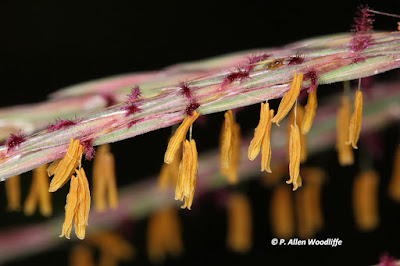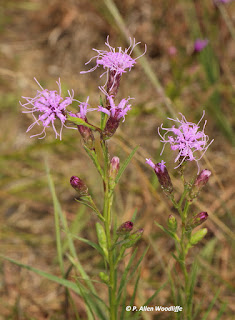The orchid I refer to is Nodding Pogonia (Triphora trianthophora), and it is a provincially and federally endangered species. While numbers of this orchid have, on occasion, been more than 1000 plants, in recent years the numbers are considerably lower. Unfortunately there has been more than one year recently where flowering was minimal and there was no successful seed production at all.
The other day, I ventured to Rondeau in the morning to check on the orchid. I have been monitoring it via some study plots for over 30 years, and for more than a decade before that, I searched for it regularly with varying degrees of success. One of its peculiarities is that the flower buds of the entire population develop to a certain stage, then on the second morning following a significant night-time drop in temperature, all of the blooms will open up....but just for the one day. It may be several days, or more than a week before the process repeats itself. Timing is everything, and one of the things we don't know is just how much of a temperature drop is required to trigger the buds to open up.
When I arrived at the spot where there were a few plants, I saw this:
They had opened the morning before, and were now closing up!
This is what I was hoping to find (photos from previous, more successful times):
But it wasn't to be on this day. Perhaps later in August.........
To get a fuller appreciation of the unusual nature and complexity of this endangered orchid, check out my earlier blog post here.
Even though I was not successful on this trip to capture the Nodding Pogonia in good flower, I did manage to see a few other things. On the walk to the orchid site, I noted these seed pods developing. This is an uncommon woodland milkweed, known as Poke Milkweed (Asclepias exaltata). The seed pods are smoother and considerably slimmer than the more abundant and widespread Common Milkweed (Asclepias syriaca).
There were some flowering grasses along the way. Grasses do have flowers, and they are wind-pollinated. These are the flowers of Big Bluestem (Andropogon gerardii), a typical prairie and savanna species. This photo shows the male parts--the anthers--dangling down, as well as the smaller purplish female flowers sitting tightly to the stem.
Sometimes the flowers are distinctly yellowish rather than purplish.
On a part of the walk along the Tuliptree Trail, I came across this little critter.
It is the nymphal stage of a Leaf-footed Bug. It is less than 10 mm in total length, and being an active little critter, was difficult to get in focus all the time.
A much larger invertebrate critter was this meadowhawk, probably a Ruby Meadowhawk, but sometimes the several meadowhawk species found in the area are difficult to tell unless you examine genitalia.
Along the beach dunes, there is a profusion of Cylindrical Blazing-star (Liatris cylindracea) coming nicely into flower. It is not a common species, but restricted to sand prairies and the sandy beach dunes of Rondeau's east beach area are perfect for it.
Maybe on my next trip to Rondeau, I will have had some success in photographing Nodding Pogonia, but if not, there is always lots of other things to focus on!















No comments:
Post a Comment